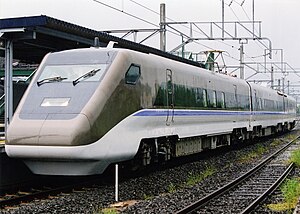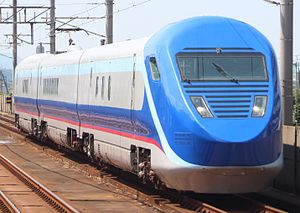|
Gauge Change TrainThe Gauge Change Train (GCT) or Free Gauge Train (フリーゲージトレイン, "FGT") is the name given to a Japanese project started in 1994 to develop a high-speed train with variable gauge axles to allow inter-running between the 1,435 mm (4 ft 8+1⁄2 in) standard gauge Shinkansen network, and the 1,067 mm (3 ft 6 in) narrow gauge regional rail network.[1] Two three-car and one four-car "GCT" electric multiple unit (EMU) trains have been built for testing. The first train operated from 1998 until 2006, the second train operated from 2006 until 2014 and the third-generation train commenced testing in 2014, although testing is currently suspended due to technical issues with the bogies.[2] The GCT was due to be introduced on the Nagasaki Shinkansen upon its opening in 2022, but JR Kyushu announced in June 2017 that it had abandoned plans to adopt the GCT for these services.[3] As a result of the abandonment of the proposed use of the GCT on the West Kyushu Shinkansen by JR Kyushu, in August 2018 JR West announced that the proposed GCT between Tsuruga and Osaka had been abandoned. There are currently no further proposals for use of the GCT, nor any development work on it. First-generation train (1998–2006)
The first GCT train was completed in October 1998.[4] It was designed to be able to run at a maximum speed of over 300 km/h (186 mph) on Shinkansen lines, and at over 130 km/h (81 mph) on conventional narrow-gauge lines under a catenary voltage of 25 kV AC (50/60 Hz), 20 kV AC (50/60 Hz), or 1,500 V DC.[5] FormationThe train was formed as shown below, with all three cars motored.
Car 1 was built by Kawasaki Heavy Industries, car 2 was built by Kinki Sharyo, and car 3 was built by Tokyu Car Corporation. HistoryAfter preparation at the Railway Technical Research Institute (RTRI) in Kokubunji, Tokyo, the train was moved to JR West tracks in January 1999 for testing on the Sanin Line at speeds of up to 100 km/h (62 mph). From April 1999, the train was shipped to the Transportation Technology Center in Pueblo, Colorado, United States for an extended period of high-speed endurance running until January 2001. Here, it recorded a maximum speed of 246 km/h (153 mph) and ran a total distance of approximately 600,000 km (372,823 mi), with approximately 2,000 axle gauge changing cycles.[6] In November 2002, the train recorded a maximum speed of 130 km/h (81 mph) on the Nippo Main Line in Kyushu.[4] From May to June 2003, the train was tested for the first time in Shikoku, running late at night on the Yosan Line between Sakaide Station and Matsuyama Station. [7] Testing on the Sanyo Shinkansen commenced on 23 August 2004 between Shin-Yamaguchi and Shin-Shimonoseki stations, delayed from the initial plan for testing to start during fiscal 2002.[4] A series of 15 return test runs were conducted late at night between 23 August and 27 October 2004, starting at a maximum speed of 70 km/h (45 mph) on the first day.[8] The maximum speed was increased to 100 km/h (62 mph) on the second day, eventually raised to 210 km/h (130 mph) on the final day.[8] Withdrawal and preservationTesting ended in 2006, after which the train was stored at JR Kyushu's Kokura Works. In April 2007, the train was moved to storage at JR Shikoku's Tadotsu Works. The Tokyu end car and Kinki Sharyo intermediate car were scrapped on-site, but the Kawasaki end car, number GCT01-1, was moved to Kawasaki Heavy Industries' Kobe factory in February 2014.[9]
Second-generation train (2006–2013)
Initially scheduled to be completed in 2004, the second train was delivered in 2006, starting test running based at JR Shikoku's Tadotsu Works. In March 2007, the train was shipped from the RTRI in Kokubunji to Kokura Works, where it was shown off to the press in May 2007. Unlike the first train which was of an original design, this train was based on the E3 Series Shinkansen, and included passenger seating in the intermediate car. Maximum speed was 270 km/h (168 mph) on Shinkansen lines operating under 25 kV AC (60 Hz), and 130 km/h (81 mph) on conventional lines operating under 20 kV AC (60 Hz) or 1,500 V DC.[10] It is not known if it could operate under 50 Hz power at either AC voltage. FormationThe train was formed as shown below, with all cars motored.
The end cars were 23,075 mm (75 ft 8.5 in) long, and the intermediate car was 20,500 mm (67 ft 3 in) long.[10] HistoryFrom December 2007, test-running commenced on conventional tracks between Kokura Works and Nishi-Kokura Station. From June 2009, the train underwent test-running between the Kyushu Shinkansen and conventional narrow gauge tracks, operating at speeds of up to 270 km/h (168 mph) on shinkansen tracks.[11] In 2011, the train was fitted with new lighter weight "E" bogies to improve stability and ride comfort when negotiating curves or points with radii of less than 600 m (1,969 ft). These replaced the previous "D" bogie design. Late night test running took place at speeds of up to 130 km/h (81 mph) on the Yosan Line from August 2011, with the train based at Tadotsu.[12] Endurance testing was then undertaken from December 2011 until September 2013 on the Yosan Line between Tadotsu and Matsuyama, during which time it covered a distance of approximately 70,000 km (43,496 mi).[13][14] Withdrawal and preservation Following withdrawal of the set, one end car, GCT01-201, was moved from Tadotsu to Iyo-Saijo in July 2014 for display at the Shikoku Railway Heritage Museum in Saijō, Ehime.[15] The two other cars, GCT01-202 and GCT01-203, were cut up at JR Shikoku's Tadotsu Works in August 2014.[15] Third-generation train (2014)
A third-generation, four-car, train was delivered to Kumamoto Depot in Kyushu in late March 2014,[16] and "three-mode" (standard-gauge - gauge-changing - narrow gauge) endurance testing using a new facility built near Shin-Yatsushiro Station commenced in October 2014.[17] Endurance testing was scheduled to continue until March 2017, accumulating a total distance of 600,000 km (372,823 mi).[17] Testing was suspended in December 2014 after accumulating approximating 33,000 km (20,505 mi), following the discovery of defective thrust bearing oil seals on the bogies.[18] FormationThe train is formed as shown below, with all cars motored.[19]
Cars 1, 3, and 4 were built by Kawasaki Heavy Industries in Kobe, and car 2 was built by Hitachi in Kudamatsu, Yamaguchi.[19] Car 2 is equipped with a single-arm current collector.[19] Seating accommodation is provided in car 2, arranged in eleven rows 2+2 abreast.[19] In June 2017, JR Kyushu revealed that it had abandoned plans to use the GCT on the Nagasaki Shinkansen (opened in 2022) citing reasons of cost and safety.[3] JR West plansJR West planned to build a gauge-changing facility at Tsuruga Station as part of a proposal to operate a GCT from there to Osaka in conjunction with the extension of the Hokuriku Shinkansen from Kanazawa to Tsuruga opening in Fiscal 2022. [20] Also starting in fiscal 2014, the company designed and built a new six-car variable-gauge trainset, which was scheduled to be tested from fiscal 2016 on the standard gauge (1,435 mm) Hokuriku Shinkansen and narrow-gauge (1,067 mm) Hokuriku Main Line and Kosei Line.[20] However, as a result of the abandonment of the proposed use of a GCT on the West Kyushu Shinkansen to Nagasaki by JR Kyushu,[citation needed] in August 2018 JR West announced that the proposed GCT between Tsuruga and Osaka had been abandoned. See also
Further reading
References
External linksWikimedia Commons has media related to Gauge Change Train. Information related to Gauge Change Train |
||||||||||||||||||||||||||||||||||||||||||||||||||||||||||||||||||||||||||||||||||||||||||||||||||||||||||||||||||||||||||||||||||











